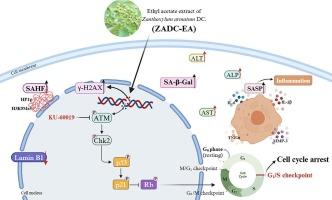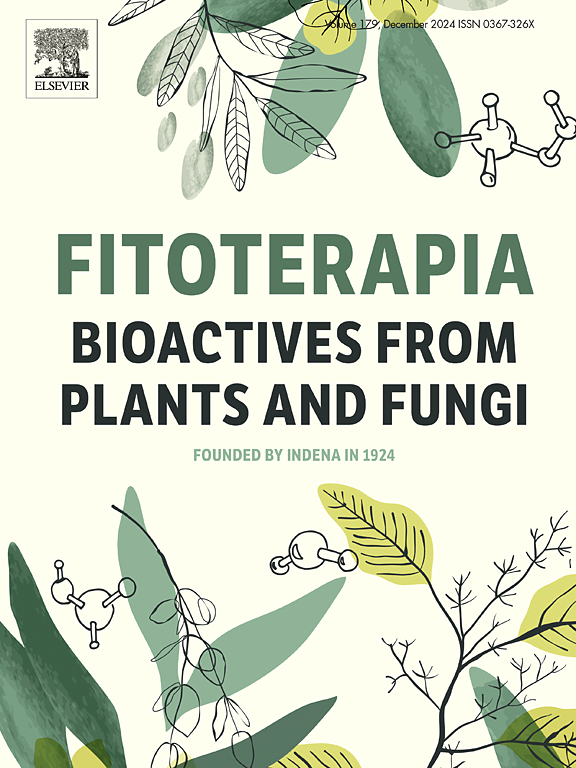花椒花椒提取物通过DNA双链断裂介导的细胞衰老途径诱导肝损伤
IF 2.6
3区 医学
Q3 CHEMISTRY, MEDICINAL
引用次数: 0
摘要
本研究的目的是全面探讨花椒对植物生长的影响。(ZADC)对肝损伤的影响,揭示其机制基础,为ZADC的安全应用奠定科学基础。材料与方法采用Q-Orbitrap LC-MS/MS对ZADC乙酸乙酯提取物(ZADC- ea)进行分析。通过测定细胞活力、肝功能指数和炎症水平来评价ZADC-EA的损伤作用。采用Western blot、RT-qPCR、流式细胞术、免疫荧光等检测DNA双链断裂(DSBs)和细胞衰老情况,旨在揭示ZADC-EA诱导肝损伤的机制。结果化学成分分析显示,ZADC-EA中含有黄酮类化合物、有机酸和香豆素。暴露于ZADC-EA导致HepG2细胞活力降低,肝损伤标志物和炎症因子水平升高。此外,用ZADC-EA处理可触发dsb并激活p53-p21通路,最终诱导细胞衰老。结论本研究为ZADC的安全性评价提供了新的视角。研究表明,ZADC-EA可通过激活p53-p21信号通路沉淀dsb,诱导细胞衰老,从而引起肝脏损伤。本文章由计算机程序翻译,如有差异,请以英文原文为准。

Zanthoxylum armatum DC. Extract induced liver injury via DNA double-strand breaks-mediated cellular senescence pathway
Aim of the study
To comprehensively explore the impact of Zanthoxylum armatum DC. (ZADC) on liver injury and disclose its mechanistic underpinnings, thereby laying a scientific foundation for the secure application of ZADC.
Materials and methods
The ethyl acetate extract of ZADC (ZADC-EA) was subjected to analysis via Q-Orbitrap LC-MS/MS. The damage effect of ZADC-EA was appraised by determining cell viability, liver function index, and inflammation levels. Western blot, RT-qPCR, flow cytometry, and immunofluorescence were employed to detect DNA double-strand breaks (DSBs) and cellular senescence, with the aim of unraveling the mechanism of liver injury instigated by ZADC-EA.
Results
Chemical composition analysis unveiled the presence of flavonoids, organic acids, and coumarins in ZADC-EA. Exposure to ZADC-EA caused a decrease in the viability of HepG2 cells and an elevation in the levels of liver injury markers and inflammatory factors. Moreover, treatment with ZADC-EA triggered DSBs and activated the p53-p21 pathway, culminating in the induction of cellular senescence.
Conclusions
The research provides a novel perspective for the safety assessment of ZADC. It has been demonstrated that ZADC-EA can precipitate DSBs and induce cellular senescence by activating the p53-p21 signaling pathway, thereby giving rise to liver damage.
求助全文
通过发布文献求助,成功后即可免费获取论文全文。
去求助
来源期刊

Fitoterapia
医学-药学
CiteScore
5.80
自引率
2.90%
发文量
198
审稿时长
1.5 months
期刊介绍:
Fitoterapia is a Journal dedicated to medicinal plants and to bioactive natural products of plant origin. It publishes original contributions in seven major areas:
1. Characterization of active ingredients of medicinal plants
2. Development of standardization method for bioactive plant extracts and natural products
3. Identification of bioactivity in plant extracts
4. Identification of targets and mechanism of activity of plant extracts
5. Production and genomic characterization of medicinal plants biomass
6. Chemistry and biochemistry of bioactive natural products of plant origin
7. Critical reviews of the historical, clinical and legal status of medicinal plants, and accounts on topical issues.
 求助内容:
求助内容: 应助结果提醒方式:
应助结果提醒方式:


